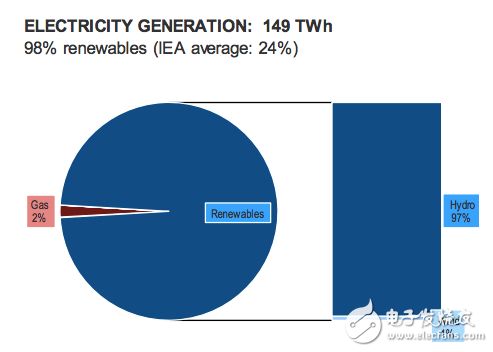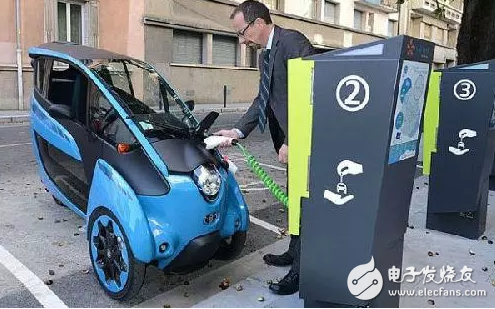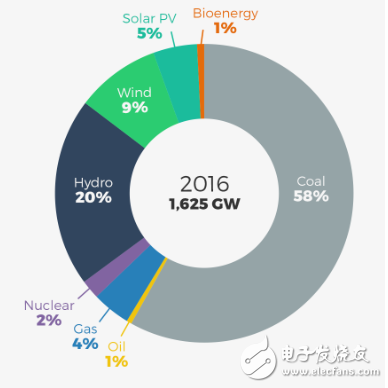
Privacy statement: Your privacy is very important to Us. Our company promises not to disclose your personal information to any external company with out your explicit permission.
The country with the largest number of electric vehicles in the world is China. However, due to the high proportion of coal-fired power generation in China, many people still insist that electric vehicles are not actually zero-emissions, and they also pollute the environment, even more polluting than gasoline vehicles.
How to crack the "electric vehicle pollution theory"?Let's look at the country with the highest penetration rate of electric vehicles in the world-Norway. In 2017, the country's BEV and PHEV market penetration rate has reached about 40%.

At an electric car parade in Norway, a leaf with the upper body cut in half was driving
Norway is not satisfied yet. The government hopes that the market share of electric vehicles will reach 100% by 2025. This also means that by 2025, fuel vehicles will completely withdraw from the Norwegian car market and turn around and drive into the museum's window to offer condolences.
The speed of the development of electric vehicles in Norway is staggering. It seems that overnight, this country with little knowledge of the Chinese will complete the whole process of transforming from gasoline and diesel to pure electric. We can find many reasons: Norwegians are rich, their economy is highly developed, and their per capita GDP exceeds 70,000 U.S. dollars (2016), ranking among the top three in the world; Norwegians pay attention to environmental protection and have a high level of education per capita, and more than half of the population have been educated. Higher Education...
However, there is another important reason: In Norway’s electricity structure, 98% is generated from renewable energy sources. This makes it unquestionable in Norway that electric vehicles do not pollute, and it also allows Norway to develop electric vehicles without any worries.
Norway: Generating 1 kilowatt-hour of electricity only emits 2.19 grams of carbon dioxideAccording to the latest data released by the International Energy Agency (IEA) in 2017, the power structure of Norway is 97% hydropower + 1% wind power + 2% natural gas.
figure 1. Norwegian power structure

Looking at the world, the average proportion of renewable energy power generation in the electricity structure of various countries is only 24%, which is far below the clean level of electricity in Norway. The single power structure in Norway is shocking. It can be said that Norway has left other countries far behind in this competition for clean electricity.
The clean power structure allows Norway to vigorously promote electric vehicles without worrying about power generation pollution. Compared with China, which is dominated by thermal power generation, Norway can also avoid quarrels such as "From the perspective of the product life cycle, whether electric cars are more environmentally friendly than traditional cars?"
According to a 2013 study on the full life cycle assessment of carbon emissions from Norwegian hydropower, the carbon dioxide produced per kilowatt-hour of electricity produced in Norway is only about 2.19g; while at the current level of electricity production in my country, the figure is 800-1100g. A few percent of China's current carbon emission intensity also makes the electric cars running on the roads of Norway very close to "zero emission".
Therefore, Norway was able to move lightly towards the goal of 100% electric vehicles.
Policy focusToday, we may not know how the Norwegian leaders judged the trend of electric vehicles in advance in the 1980s and 1990s.
What we know is that in the last decade of the twentieth century, the Norwegian government and parliament promoted and promulgated a series of laws and policies to promote and popularize electric vehicles, including the exemption of annual registration taxes and fees for electric vehicles and the exemption of electric vehicle tolls. In 2000, electric vehicles were also given the right to travel on bus lanes and to board ferry boats for free. Beginning in 2008, the Oslo City Government began operating the first urban charging piles. By 2012, more than 10,000 charging piles had provided charging services for electric vehicle travel. And it was from then that the Norwegian people began to widely accept electric vehicles.

Electric cars charging on the streets of Norway
After nearly 30 years of vigorous publicity and promotion, Norway has become the country with the highest degree of auto electrification in the world, and it has full confidence to call out the goal of 2025: a total ban on the sale of fuel vehicles.
China's power generation must accelerate clean-upOn the other hand, although the development situation of electric vehicles in China is very good, we must not forget that the current generation structure that is not clean enough is the sword of Damocles that has been hanging over our heads.
figure 2. China's power structure

In China, there has been controversy about whether electric vehicles are truly environmentally friendly. However, Professor Wang Hewu of Tsinghua University stated that even according to the current power structure, electric vehicles are still a cleaner choice than fuel vehicles in China.
However, there is no doubt that if China's power generation sources are further cleaned, the government and society can also use electric vehicles on a larger scale without worrying about pollution.
According to the latest data from the National Bureau of Statistics, as of the end of 2017, China's non-fossil energy power generation accounted for approximately 30.4% of total power generation, an increase of 1.0% year-on-year; on the other hand, thermal power generation accounted for approximately 30.4% of total power generation. Decreased year by year, the proportion fell to 71.8% in 2017.
Taking into account the objective facts, it will be difficult for China to reach the level of Norway's power structure in a short period of time. However, at the beginning of 2018, the National Energy Administration expressed the hope that "by 2020, non-fossil energy will account for about 15% of total primary energy consumption, and carbon dioxide emissions per unit of GDP will drop by 40% to 45% compared to 2005. ; By 2030, non-fossil energy will account for about 20% of total primary energy consumption, and carbon dioxide emissions per unit of GDP will drop by 60% to 65% compared to 2005."
The increase in the proportion of non-fossil energy in primary energy consumption means that traditional fossil energy such as oil and coal will gradually be replaced by cleaner and more efficient technologies such as nuclear energy, wind energy, and hydropower. According to the data of the China Electric Power Development Report 2017, 2017 In the year, the proportion was 13.8%. Electricity production has always been the highlight of energy consumption. Reducing the use of fossil fuels from the source will play a very positive role in increasing the proportion of my country's non-fossil energy power generation. Therefore, my country's electricity production will also be cleaner.
The statement of the National Energy Administration is not only to help the development of domestic electric vehicles in the future, but also to reiterate and emphasize the commitments made by China in the Paris Agreement. It can be seen that improving the power structure will be our country in the coming decades. An important issue in the energy sector.
Therefore, to crack the "electric vehicle pollution theory", first of all, it is not necessary to support the zero emission of electric vehicles, but to admit that the current power generation link is not environmentally friendly and focus on clean power generation. In this way, the "electric vehicle pollution theory" will come to an end in China.
November 21, 2024
November 14, 2024
この仕入先にメール
November 21, 2024
November 14, 2024
January 19, 2021

Privacy statement: Your privacy is very important to Us. Our company promises not to disclose your personal information to any external company with out your explicit permission.

Fill in more information so that we can get in touch with you faster
Privacy statement: Your privacy is very important to Us. Our company promises not to disclose your personal information to any external company with out your explicit permission.